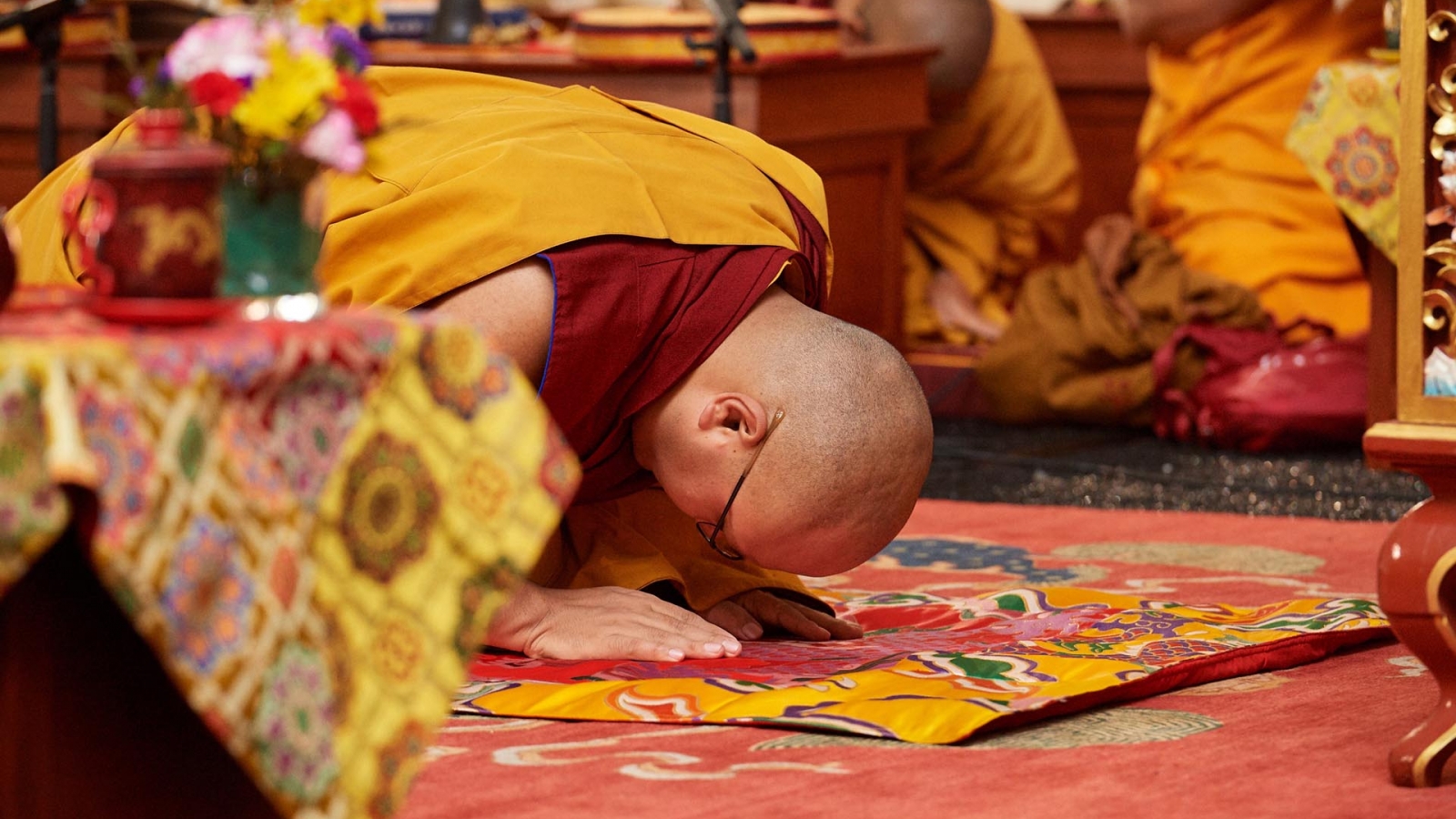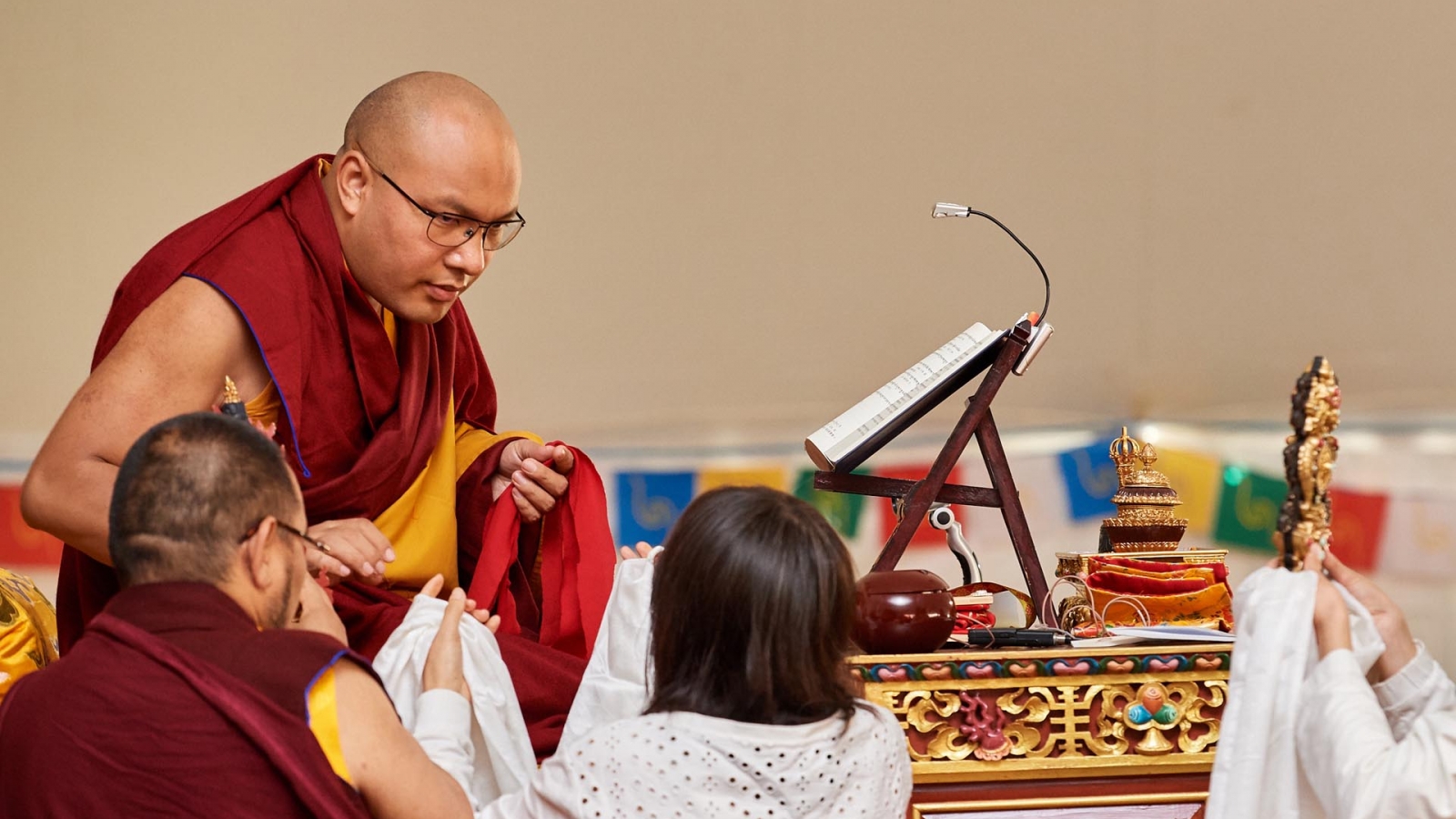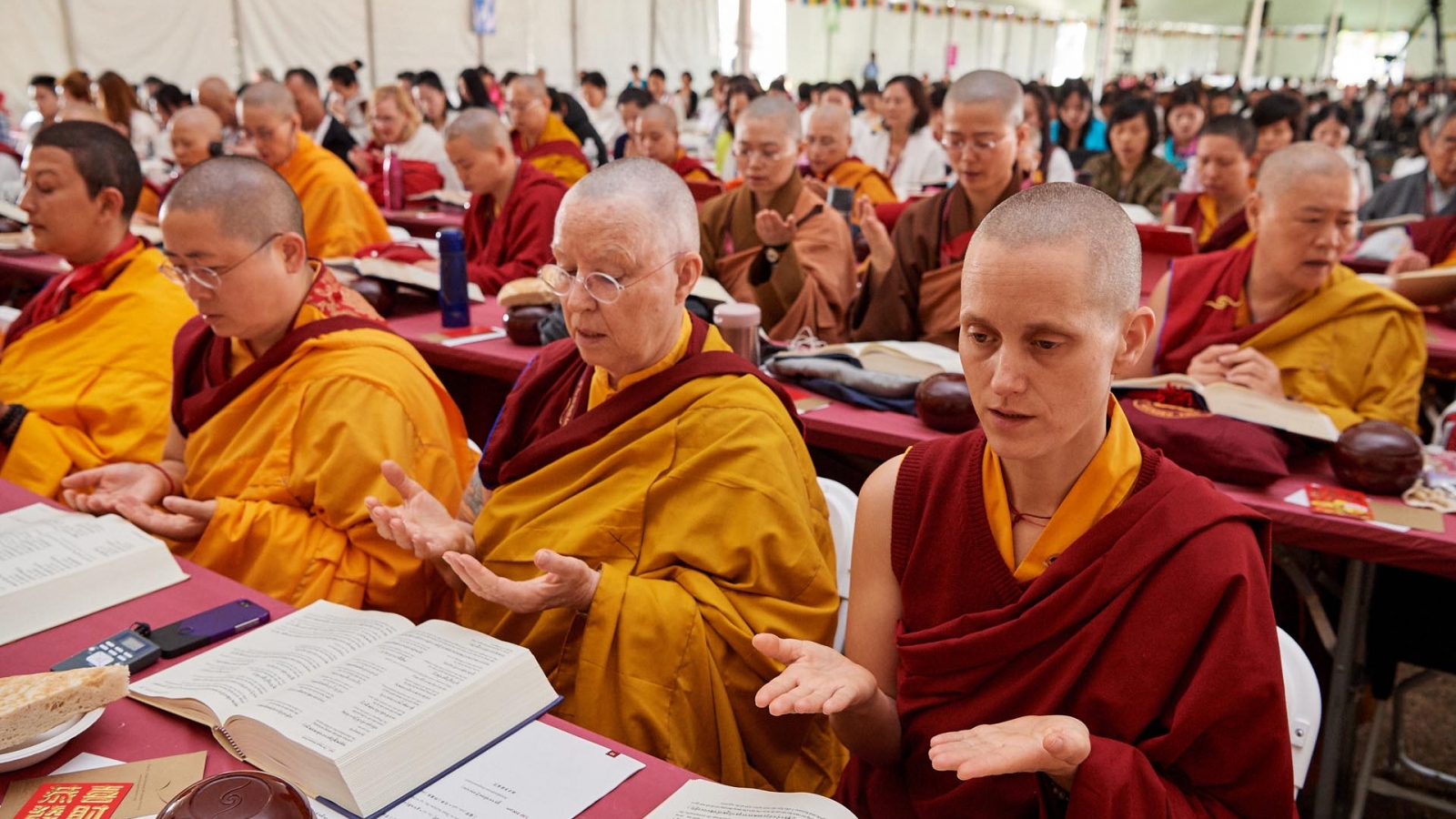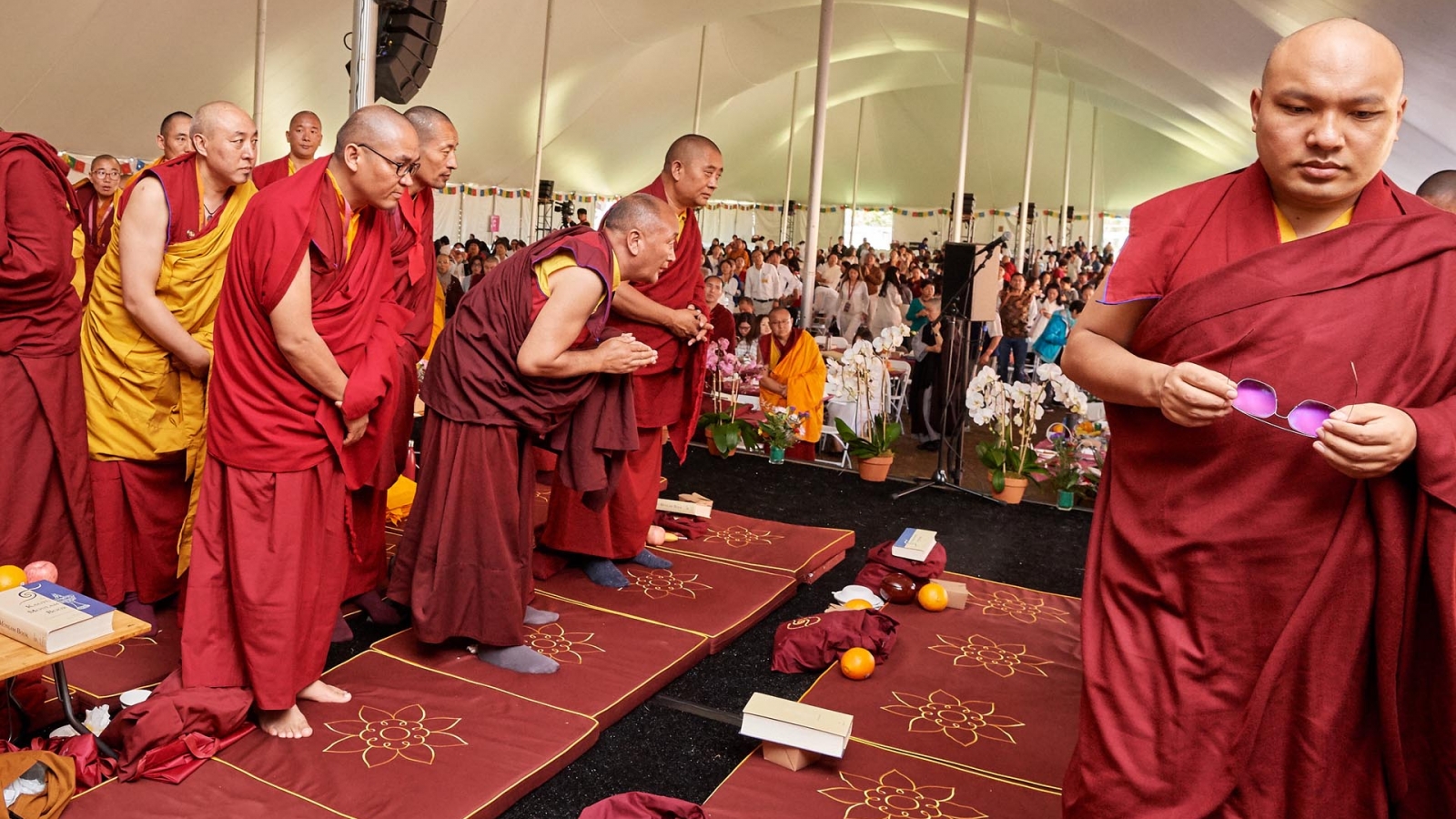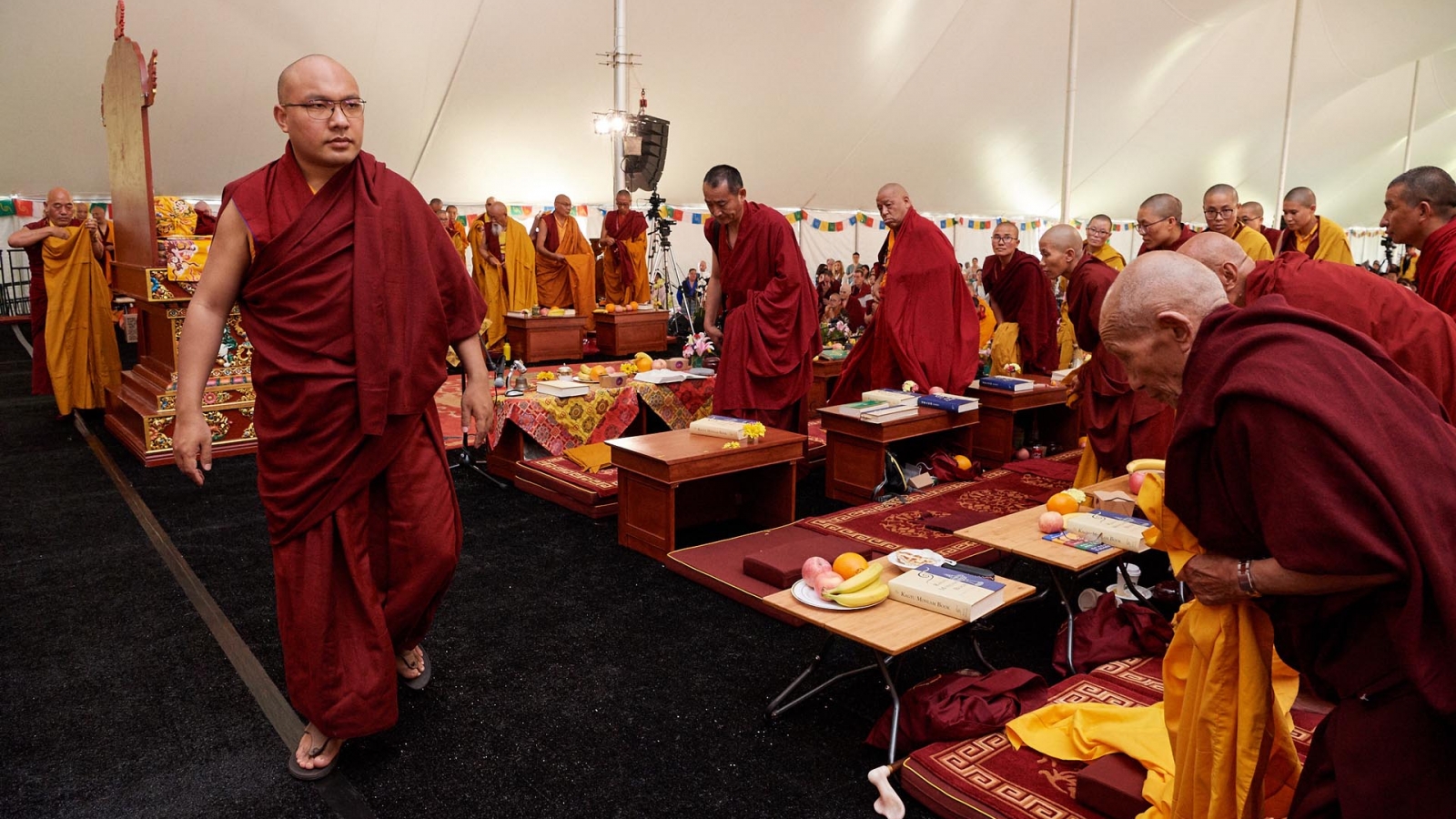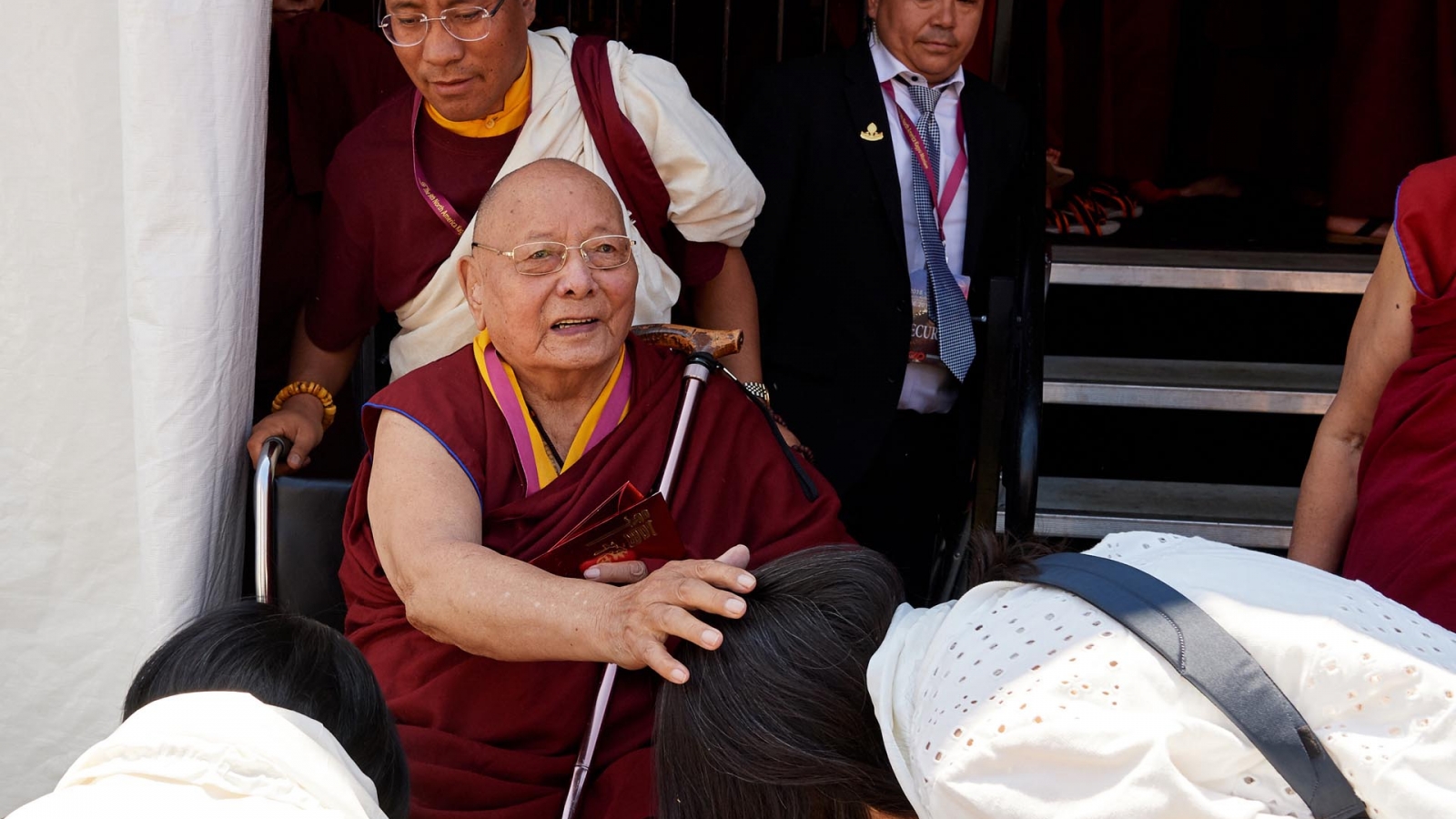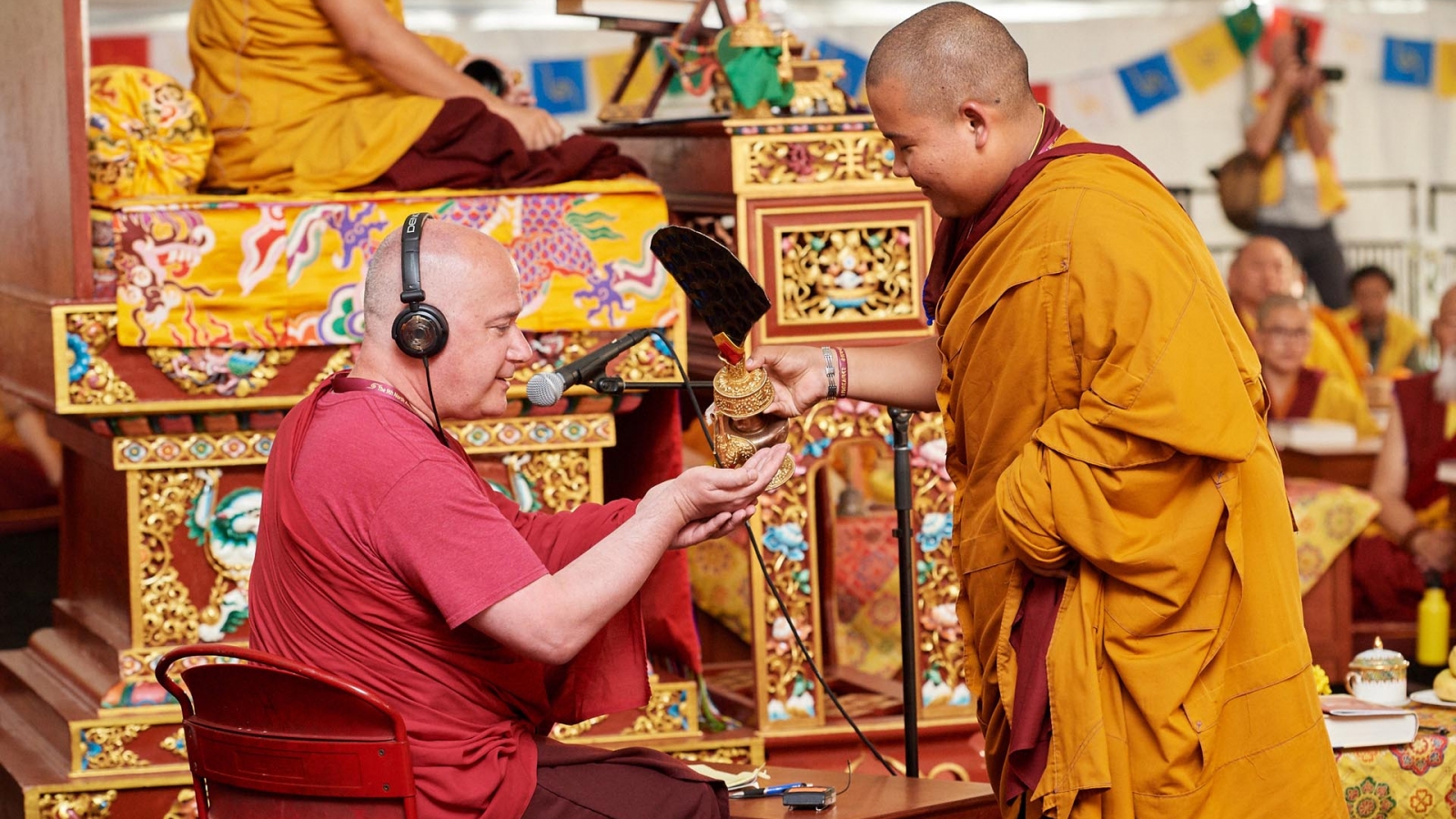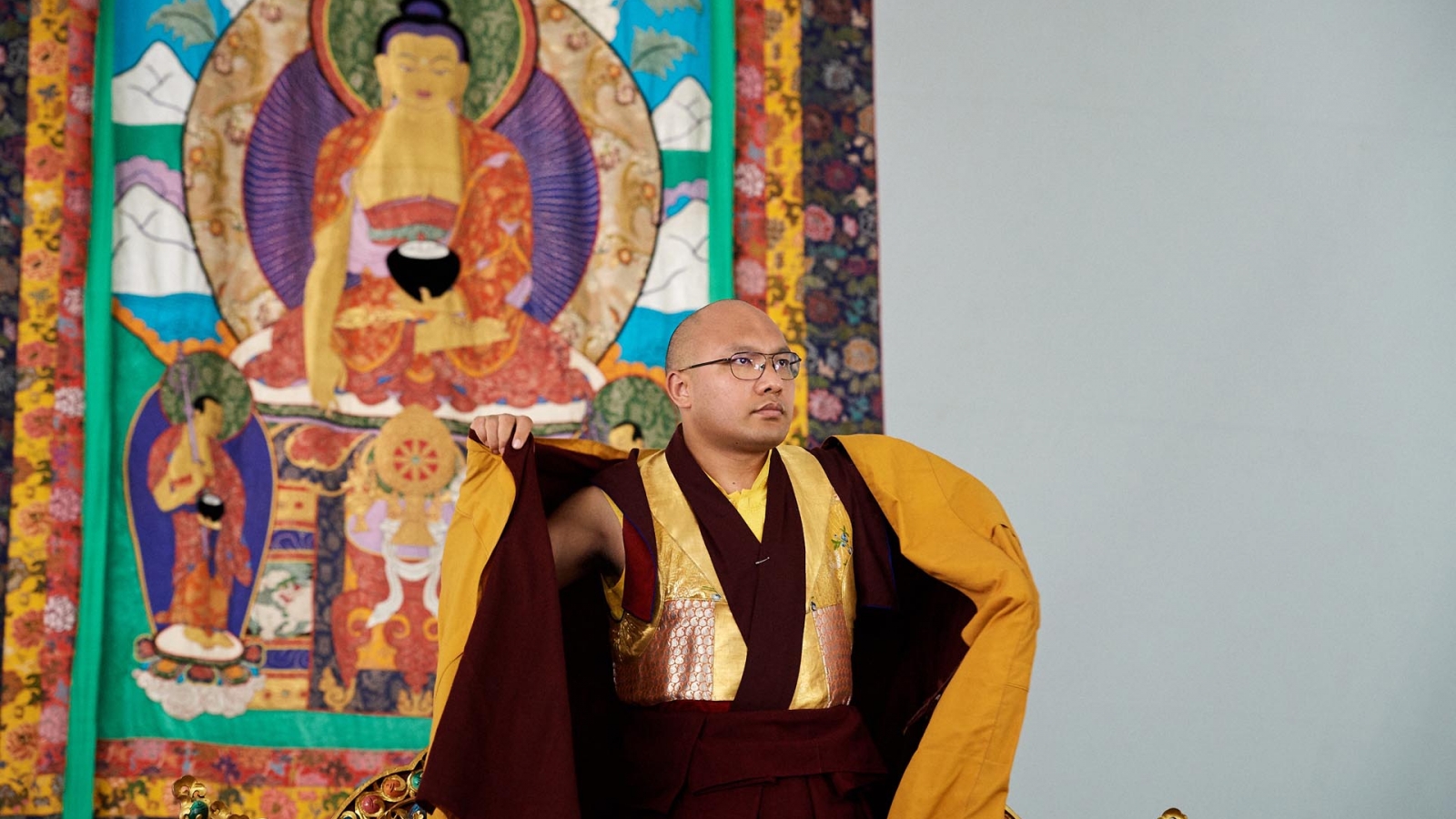North American Kagyu Monlam, York College, Queens, New York // June 9, 2018
This afternoon the Gyalwang Karmapa completed his teachings on the Three Principle Aspects of the Path and then gave the empowerment of Chenrezik to the thousands who had gathered for this final day in the lofty tent. The Karmapa began by placing the topic of his talk in the framework of the text.
“We have now come to the third section of the text, which presents the correct view, the view of emptiness or the Middle Way (Madhyamaka) philosophy. As in the previous two sections of the desire for liberation and giving rise to bodhichitta, this one also has three parts: the reason why a correct view is necessary, the ways to develop it, and the measure of its achievement. The next stanza relates to the first part:
If we do not have the wisdom that realizes the nature of all things,
Though we may cultivate the desire for liberation and bodhichitta,
We’ll be unable to cut the root of further becoming.
Therefore, strive to realize what interdependence is.
“This verse points to the critical importance of imbuing our minds with the view of emptiness. The root of further becoming, or samsaric existence, is our fixation on a self, and the sole remedy is the direct realization of the correct view of emptiness. Desiring liberation and generating bodhichitta alone are not enough. To develop this direct realization, we first have to understand and be able to recognize the fabricated “self” we impute onto individuals and things. Knowing its nature clearly enables us to uproot this obstacle to enlightenment. Therefore, for those wishing true liberation, realizing emptiness is absolutely essential.
“The fourth line encourages us: ‘Therefore, strive to realize what interdependence is.’ There are different ways of framing interdependence, for example, it can be presented as interdependent origination, or the interdependence of cause and result. But here, the broader emphasis is on how all things are imputed or come about through the gathering of causes and conditions—they can only arise in depending on something else.
“The next verse speaks of the means for realizing the correct view:
Whoever sees that for all things of samsara and nirvana
Cause and result infallibly follow one after another,
And see that every mental reference point falls apart,
This person has entered a path that delights the buddhas.
“Of two main points in the verse, the first is expressed in the two initial lines: All the things that make up samsara and nirvana—the environment and its inhabitants, the whole and the parts, the subjects and objects of experience, and so forth—all of them, are dependently arisen. They are a continuous linking or concatenation of cause and effect, and in being so, they are merely imputed objects, just labels or only names. We should train steadily and become certain about this unfailing flow of cause and effect.
“If this interdependence is seen, then all concepts are destroyed. This refers to the second point made in the third line, ‘And then see that every mental reference point falls apart.’ Concepts, such as grasping onto the “self” or grasping onto “objects” as inherently existent, fall apart and fade away. If that happens, then we have entered the correct view, the path of the Middle Way, which ‘delights the buddhas’ (line four).
“In brief, things do not exist in the way they appear to us as if they were actually there, as if they had an inherent nature. Nevertheless, due to dependent arising, we cannot say that something like mere appearance is nonexistent. This is similar to the situation of a TV screen, which shows us people and places that merely appear but do not really exist. They are delusive appearances that arise due to the coming together of causes and conditions that we call interdependence. Another way we could express this arising of nonappearance is to say that appearance and emptiness are inseparable.
“When Buddhists use the words empty or emptiness, people often think it means nothing at all, a complete absence of anything or a kind of vacuum. Yet in a certain sense, emptiness is not nothingness; rather, it provides the opportunity for anything at all to arise. This openness is often called the source of all things, for the nature of emptiness is the open possibility for any appearance to arise. Therefore, emptiness is not a blank nothingness, which can frighten people, but it has this very profound and true meaning.
“Following this stanza comes the third section of explaining the correct view, which has three parts: indications that our analysis of the view is incomplete; the indications that it is complete, and the other special understandings that come with the completion of analysis. The first one is explained in the next stanza:
As long as our understanding of the unfailing interdependence of appearances
And our understanding of emptiness beyond assertion
Appear to us as separate from one another, for that long
We have not realized the wisdom of the Buddha Shakyamuni.
“This shows that we have not realized primordial wisdom if we still think that dependently arising appearances and emptiness beyond elaboration are somehow separate or mutually exclusive like hot and cold. From another perspective, we could state that the interdependent appearances that arise for us are contaminated by our grasping onto them as truly existent. Therefore, some of the Gelukpa commentators on the Middle Way state that we should negate present appearances to the mind, meaning that we should turn around our fixation on these appearances as truly existent in the moment they arise. There are many other explanations of the early Middle Way commentators, but we do not have time to go into them now.
“The next stanza describes the situation in which our analysis is complete:
When all at once without fluctuating,
We simply see dependent arising as infallible
And our consciousness that reifies objects falls away,
At that moment our analysis of the view is complete.
“’Without fluctuating’ is easy to understand, but ‘all at once’ or ‘simultaneous’ is more difficult and requires looking into the stages of the path. Before we arrive at the direct realization of emptiness that constitutes the path of seeing, there is the stage known as the path free of obstacles, which leads into the direct seeing of emptiness. At this point, what appears is an aspect or a form of emptiness, and there is much discussion about whether this constitutes realization of emptiness or not.
“Whatever conclusion might be drawn, we may have to say that the aspect of emptiness that appears as the path free of obstacles does belong to relative truth. The aspect’s essential nature, however, is emptiness. And the essential nature of this appearing aspect of emptiness and the essential nature of the mind that knows it, are inseparable. Therefore, in this context, the appearing aspect of emptiness and its realization are not separate. “In the third line of the verse, ‘the consciousness that reifies objects’ or ‘the consciousness that grasps onto certainty’ can be understood in several ways, and perhaps the most apt here is the meaning of ‘grasping onto the true existence of objects.’
“It is also said about emptiness that if something exists it is emptiness and if something does not exist it is also emptiness, thus indicating the emptiness of the two extremes of existence and nonexistence. The next verse develops that statement in the third section on the correct view, the other special understandings that come with the completion of analysis:
Further, eliminating the extreme of existence by knowing appearance
And the extreme of nonexistence by knowing emptiness,
If we know how emptiness arises as cause and effect,
We will not be captivated by the view of extremes.
“What is being described here is that if we know the reason for appearances, we can negate the existence of a truly existent object or the extreme of permanence. If we know the reason for emptiness, we can negate a blank nonexistence or the extreme of annihilation. If we understand how interdependence appears as the infallible sequencing of cause and result, we will not be misled by the allure of these two extreme views, permanence and annihilation.
“Now we have come to the conclusion, which has two parts: the encouragement to practice and accomplish our own long-term good, and the colophon. The first part relates to the final stanza:
Thus, my child, when you have realized just as they are
The key points of the Three Principle Aspects of the Path,
By relying on solitude and generating powerful diligence,
Focus only on swiftly accomplishing your ultimate goal.
“This needs little explanation, and so we will turn to the colophon:
These instructions were presented by the learned bhikshu Lozang Drakpa to Tsakho Pönpo, Ngakwang Drakpa.
“Tsakho Pönpo was one of Je Tsongkhapa’s heart disciples, practicing in his oral lineage. Not only had he realized emptiness but he was also the scribe for many of Je Tsongkhapa’s teachings. The later great master of the Geluk lineage, Chökyi Lekpa Döndrup, is said to have been a rebirth of Tsakho Pönpo.
“This has been what I would call a fairly skimpy presentation of the Three Principle Aspects of the Path and not what I would consider a full one, but at least it is enough not to ruin the auspicious interdependence of the occasion. Originally, I had thought that the three topics of the text would fit nicely into the three days of teaching during the Monlam. It did not work out exactly that way, but at least today we have finished a presentation of the text.
“Lord Rinpoche, as Je Tsongkhapa is sometimes called, is one of the most amazing scholars and masters of meditation that Tibet has known. He also had two heart disciples who resembled the sun and moon. From within the Kamtsang Kagyu lineage, the Fourth Karmapa, Rölpay Dorje, was very close to the young Je Tsongkhapa. Rölpay Dorje gave him upasaka vows and the name, Kunga Nyingpo. One could continue on about this, but even more important is the fact that both the Kagyu and the Geluk lineages practice together the mahamudra and the Kadampa teachings. Gampopa holds Milarepa’s lineage of mahamudra, which he combined with his earlier practice in the Kadampa tradition, stemming from Lord Atisha, into a single stream of study and practice. Similarly, Je Tsongkhapa practiced extensively the Kadampa teachings on path and fruition to the point that his tradition is sometimes called the New Kadampa, and he also engaged in mahamudra meditation. In this way, through their combined practices of mahamudra and Kadampa instructions, which continue down to this day, the Kagyu and Geluk lineages have a very close connection.”
On this harmonious note, the Karmapa began the empowerment of Chenrezik, which points to another close relationship between the two lineages. Both His Holiness the Dalai Lama and His Holiness the Karmapa are considered emanations of this deity who embodies the compassion of all the buddhas. Thus in one day, those present in the broad tent at York College, experienced the two main wings of the bird that soars along the path to full awakening—emptiness and compassion.
At the end of the empowerment, multiple mandala offerings were made by the Danang Foundation and others. Tsewang Rinpoche, the director of the Foundation, gave extensive thanks to His Holiness and to all who supported this very successful Ninth North American Kagyu Monlam. This was followed by prayers with a sea of white scarves waving in the air, for auspiciousness by Marpa and Milarepa, and the Aspiration for the Well-Being of Tibet. Finally, the Monlam flag with its swirling emblem was passed on to the next host of the tenth North American Kagyu Monlam, Thrangu Rinpoche’s monastery in Vancouver, whose representative waved it back and forth as he approached the Karmapa to receive his blessing and a white scarf.


